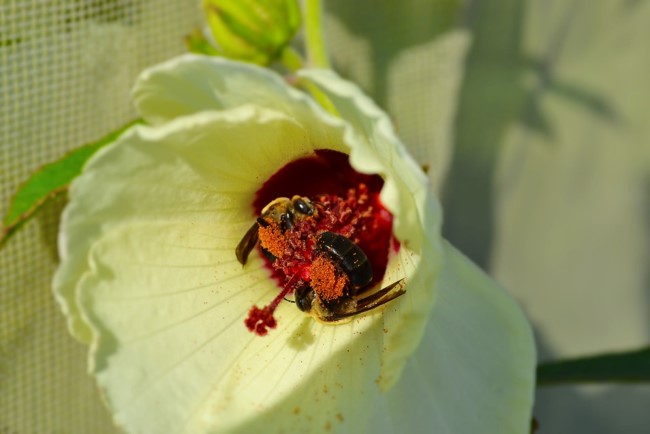Aggression between floral specialist bees enhances pollination of Hibiscus (section Trionum: Malvaceae)
DOI:
https://doi.org/10.26786/1920-7603(2016)11Abstract
Specialist oligoleges are bees with narrow dietary niche breadths often touted to have foraging specializations that enhance their pollination efficiency above that of co-foraging generalists (polyleges) such as honeybees Apis mellifera L. This study and many comparative pollinator efficacy studies in crops show that oligoleges on a per bee basis are not always the most efficient pollinators. Percentage of stigmatic contact visits by populations of oligolectic Ptilothrix bombiformis (Cresson) in Maryland and Mississippi show that adult bees contact stigmas and transfer 70+ pollen grains during 2% - 3% of floral visits. As low as these percentages seem, pollination efficiency of this bee varies from negative values due to the removal of stigmatic pollen during some visits to increases of 30% as Hibiscus petals close and spikes of 300% - 1000% as Ptilothrix adults display aggression inside flowers. Aggressive P. bombiformis tussle with each other, often grappling with, lunging at, and biting conspecifics. Opponents will often lose their balance, tumble around inside flowers and, in the process, more efficiently pollinate host blooms. Such aggressive interactions constituted 5% of visitation bouts to Hibiscus flowers, yet accounted for ~20% of contact visits that transferred 10 or more pollen grains per stigma. Tussles therefore represent brief agonistic entanglements that can enhance the pollination efficiency of solitary bees at host plants with large herkogamous blooms. More complex behavioural interactions between different sexes and species of foraging bees may explain the importance of greater bee diversity to overall pollinator effectiveness.
Downloads
Published
How to Cite
Issue
Section
License
Copyright (c) 2016 Blair Joseph Sampson, Cecil T Pounders, Christopher T Werle, Trevor R Mallette

This work is licensed under a Creative Commons Attribution 4.0 International License.
JPE is an open access journal which means that all content is freely available without charge to the user or his/her institution.
Authors who publish with this journal agree to the following terms:
1) Authors retain copyright and grant the journal right of first publication with the work simultaneously licensed under a Creative Commons Attribution License that allows others to share the work with an acknowledgement of the work's authorship and initial publication in this journal.
2) Authors are able to enter into separate, additional contractual arrangements for the non-exclusive distribution of the journal's published version of the work (e.g., post it to an institutional repository or publish it in a book), with an acknowledgement of its initial publication in this journal.
3) Authors are permitted and encouraged to post their work online (e.g., in institutional repositories or on their website) prior to and during the submission process, as it can lead to productive exchanges, as well as earlier and greater citation of published work (See The Effect of Open Access).
To assure a broader targeted audience, content will be included into databases (such as EBSCO) and directories (such as DOAJ).











